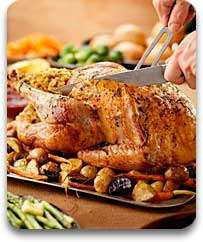Kansas State University’s Blakeslee outlines ways to keep food
safe and reduce cook’s stress
MANHATTAN, Kan. – The coronavirus pandemic means many of us will gather in smaller groups than usual for Thanksgiving. That may also mean there will be more people preparing their first turkey with all the trimmings. Whether you’re a complete rookie or an experienced cook, chances are that you don’t prepare a holiday turkey and multiple side dishes every day.
Kansas State University food safety specialist Karen Blakeslee says there are ways to avoid last-minute stress and keep food safe when putting it all together.
“Plan a simple meal to reduce extra stress,” she said. “For a smaller group, buy a smaller turkey or even a turkey breast. Cornish hens would be a good substitute.”
One way to share the day if you can’t be together is to have a recipe exchange of holiday favorites, she added.
Blakeslee, the coordinator of the K-State Research and Extension Rapid Response Center, provided these tips for before and after the holiday meal:
- Make a list well ahead of the holiday. Include a timeline when activities should happen, whether five days before the meal, two days before or two hours before. Will the turkey go in the oven? In a countertop roaster? If the turkey will take up oven space, think about other foods you’ll prepare and how. Utilize your stovetop, slow cooker or electric pressure cooker.
- Wash your hands often throughout food preparation.
- If you want a fresh turkey, order it ahead so your store will have it ready. Pick up the fresh turkey one or two days before preparation.
- A frozen turkey can be purchased much earlier. Store it in the freezer until it’s time to thaw and cook it. Watch for sales at this time of year.
- How long to thaw the turkey depends on the size of the turkey. Plan for a 12- to 16-pound turkey to thaw for a full week in the refrigerator. If thawing a smaller one, move it from the freezer to the refrigerator the weekend before Thanksgiving.
- Forgot to thaw the bird in advance? Submerge it in clean, cool water in a large pot, but change the water every 30 minutes or so. This takes about 30 minutes per pound as opposed to several days in the refrigerator. Never thaw any meat at room temperature.
- If you forget to thaw the frozen turkey, it can be cooked from a frozen state, but it will take about 1-1/2 times the amount of time that it would take to cook a thawed turkey.
- When prepping the turkey, there’s no need to rinse it. Food scientists say rinsing any meat or poultry can splash water with bacteria on countertops and other foods. Cooking it properly will take care of any potential bacteria.
- Cook turkey at 325 degrees F or higher until a meat thermometer inserted in the meatiest area, typically the thigh, shows 165 degrees F. Take readings in a couple of places.
- Cover the turkey with a lid or aluminum foil to ensure consistent cooking. Take the lid or foil off toward the end of cooking for extra browning.
- Don’t rely on pop-up thermometers only. Pop-up thermometers that come with some turkeys indicate temperature, but not the true temperature of the innermost part of the turkey. These can pop up before the bird is cooked through.
- Making stuffing? Bake in a separate pan from the turkey, so it easily reaches (also required) 165 degrees F. If you stuff the bird, stuff it loosely. Packing it tightly slows down the time to reach 165 degrees F.
- Let the turkey “rest” for 15-20 minutes when it comes out of the oven. It helps the juices reincorporate into the meat.
After the meal
- To help prevent foodborne illness, don’t let food sit out more than two hours after it comes out of the oven or off the stove. That invites potential bacterial growth and no one wants foodborne illness after a nice holiday meal.
- Keep cold foods cold and hot foods hot. Avoid leaving perishable foods in the temperature danger zone, 40-140 degrees F, for more than two hours.
- Turkey meat will chill faster if you take the meat off the bones. Save the bones in the refrigerator or freezer to make turkey soup.
- Store leftover foods in a flat, wide container (about 2 inches high) before refrigerating if possible. That helps it chill faster which keeps bacteria from growing. Freeze leftovers that cannot be used within three to four days.
“Remember, take time to plan out the meal, keep safe food handling tips in mind, and enjoy your time with family and friends,” Blakeslee said.
More information is available from K-State on the general food safety website and on the holiday food safety webpage.
FOR PRINT PUBLICATIONS: Links used in this article
K-State Research and Extension Food Safety www.ksre.k-state.edu/foodsafety
K-State Research and Extension holiday food safety, www.ksre.k-state.edu/foodsafety/topics/holiday.html
K‑State Research and Extension is a short name for the Kansas State University Agricultural Experiment Station and Cooperative Extension Service, a program designed to generate and distribute useful knowledge for the well‑being of Kansans. Supported by county, state, federal and private funds, the program has county extension offices, experiment fields, area extension offices and regional research centers statewide. Its headquarters is on the K‑State campus in Manhattan. For more information, visit www.ksre.ksu.edu
Story by: Mary Lou Peter, mlpeter@ksu.edu
For more information: Karen Blakeslee, kblakesl@ksu.edu





